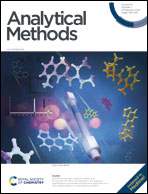AIE active fluorescent organic nanoparticles based optical detection of Cu2+ ions in pure water: a case of aggregation–disaggregation reversibility†
Abstract
An AIE-active pyrene-terpyridine derivative, (4′-(pyren-1-yl)-2,2′:6′,2′′-terpyridine) (1) was found to form nanoaggregate in an aqueous medium. The probe involved hydrogen bonding with solvent molecules that modulated the charge transfer behavior and consequently resulted in different spectroscopic behavior due to the formation of fluorescent organic nanoparticles (FONs). In the presence of Cu2+ ions, FONs displayed a ratiometric red shift of the absorption band (360 to 420 nm) accompanied by a prominent naked-eye color change from colorless to light yellow. With a gradual increase in water content, 1 displayed a huge red shift of the emission band (430 to 475 nm) denoting its switching from monomer to FONs. In the presence of Cu2+, the 475 nm emission band of FONs gradually diminished, facilitating the micromolar scale detection of Cu2+ (LOD = 8.57 μM) in a 100% aqueous medium with a fluorogenic color change from cyan to dark. The SEM and DLS data indicated the cation-induced disaggregation of FONs, which was further confirmed by mass spectral analysis and electron paramagnetic resonance measurement. In addition, the high selectivity of FONs towards Cu2+ ions over other potential cations and the 2 : 1 (1-Cu2+) binding stoichiometry were also determined. Moreover, the spectroscopic behavior of the monomeric amphiphilic probe was well supported by extensive DFT study. Such detection of Cu2+ ions in pure aqueous medium denoting an aggregation–disaggregation event is very rare in the literature.



 Please wait while we load your content...
Please wait while we load your content...